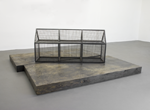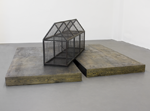

When works lie around in my studio they act on what I think about and are often temporari[y adapted in one way or another. They risk being contingent to circumstance and fortune. Bloody House is no exception. That is not to say that the first intention and meaning is undermined or that the motivations in the first place are abandoned or forgotten. But when in the studio they are part of the ongoing debate I have with myself about making art.
Bloody House is no exception.
I have shown it four times in different circumstances. It has become more austere, as though the intended meaning having been subject to influence and circumstance is sharper now than it has been before.
The idea is simple enough. It refers to an idea of family idealised as `perfect` consumers within a social framework which contains the dialectic antithesis, its otherness, murder violence, brutality,avarice greed etc. House is a term signifying to basic needs of protection, shelter, safety etc.`of course it is much more than that but is rooted to the basic needs in life. Bloody house then expresses the experience of family and house as being both physically and psychologically brutalising. It is this confrontation with desire expressed by the illusion of ideal consumption within the family group as a bulwark of social security and well being in the internecine chaos of warring market economies. Bloody House as representation sits close to the chaos. The glass floor and the grid structure of the form is both open and inclusive. The stained but still reflective floor is the site of contradictions where the experience of body, thought and feeling is expressed. The mirror acts as as an incontinent element denying the solidity of ground taking in images which are reflected in and out like water or mercury, elusive, unfathomable.
The house stands as a simple representation rigid and also incontinent its surfaces open to its surroundings. The closed family house where the unacceptable lurks witness Louise Bourgeois`s childhood in bourgeois circumstances according to her own telling, is opened and found to be bloody site of inter warfare between the sexes the generations. It rests on the notion of property on the values of the bourgeoisie which blown to elephantine proportions are in collision with the idea of community democratic processes and nation state. Bloody house in effect signifies to the struggle.
Stuart Brisley 2010
Bloody House, which incorporates a metal structure that has been shown several times before in different circumstances. When the structure was exhibited at St Pancras Station in 1992, accompanied by a text-work by Maya Balcioglu, the focus was on ‘the rootless condition of society and the resultant consequences for those without roots’. However, this new incarnation of Bloody House explores the lot of those who do have a home and apparent place in society.
Bloody House evokes events that may take place inside a suburban family house: it refers to unspecified tragedies of domestic violence, sexual molestation, and entrapment. The ‘house’ contains the secrets of what lies beneath the assumed conventions of social behaviour, and is also the focus of the hollow dreams of its inhabitants as they make their way back from labouring in the city. This notion of the ‘house’, conventionally thought of as a retreat and place of refuge, shows it to be instead a place of potential danger. Bloody House also serves as a political symbol of other ‘houses’ that also have secrets hidden beneath their exterior façades, from the Houses of Parliament to the House of Windsor.
Brisley has used ‘cages’ in his work since his neon structures of the late 1960s, and physically broke in to one in an early performance. In his assemblage sculpture 1=666,666 (1983), he displayed 66 found gloves filled with plaster in a cage structure (each glove represented 66,666 unemployed people, and sixty-six times this number was the rate of unemployment in Britain at the time). Nul Comma Nul, an installation from 1984 (now in the collection of Tate, London), was shown in the Orwell-inspired exhibition 1984 at Camden Arts Centre. In this work, Brisley combined a cage with light and discarded clothing to convey the all-encompassing nature of ideology and the claustrophobia caused by the lack of social space in the author’s dystopian vision.
Brisley’s solo exhibition at the Serpentine Gallery in 1987 included a row of large images of the IRA activist Mairéad Farrell during the ‘Dirty Protests’ in Armagh prison in the early 1980s – these were displayed behind a forbidding metal grille or cage which immediately suggested connotations of imprisonment and surveillance. This installation, one of Brisley’s most potent political works, has resonated over the years in the work of younger artists such as his former student at the Slade, Mona Hatoum, who has also used cage structures to create political and psychic boundaries, and questioned the sense of safety and comfort assumed implicit in the concept of ‘home’. As Richard Gott wrote in 1996: ‘Homage to Brisley’s performances and installations, references to his work, can be found in many unexpected places and in the work of other artists.’
Brisley sees cages as psychological spaces, and Bloody House centres on a menacing cage-like structure with no solid walls – it is contained, but can be permeated by the outside. It sits on a dais that is split in to two sections creating a chasm implying the insecurity that lies beneath the house. The French/American artist Louise Bourgeois has also used the ‘cage’ as a psychological metaphor for the terrors dormant in the family home – in Cell (Choisy) (1990–93), the first of her series of large cages, she placed a model of her childhood home in a metal chain-link cage with a threatening guillotine suspended above the entrance.
Jane England 2009